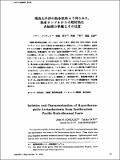Por favor, use este identificador para citar o enlazar a este item:
http://hdl.handle.net/10261/159668COMPARTIR / EXPORTAR:
 SHARE
BASE SHARE
BASE
|
|
| Visualizar otros formatos: MARC | Dublin Core | RDF | ORE | MODS | METS | DIDL | DATACITE | |

| Campo DC | Valor | Lengua/Idioma |
|---|---|---|
| dc.contributor.author | González Grau, Juan Miguel | es_ES |
| dc.contributor.author | Sato, Takato | es_ES |
| dc.contributor.author | Kato, C. | es_ES |
| dc.contributor.author | Horikoshi, Kobi | es_ES |
| dc.date.accessioned | 2018-01-25T12:34:46Z | - |
| dc.date.available | 2018-01-25T12:34:46Z | - |
| dc.date.issued | 1994 | - |
| dc.identifier.citation | Journal of Deep Sea Research 10: 471-480 (1994) | es_ES |
| dc.identifier.isbn | 1340-7848 | - |
| dc.identifier.uri | http://hdl.handle.net/10261/159668 | - |
| dc.description | 10 páginas.-- 4 figuras.-- 1 tabla.-- 13 referencias.-- El autor González Grau, Juan Miguel pertenece actualmente al Instituto de Recursos Naturales y Agrobiología de Sevilla | es_ES |
| dc.description.abstract | Two hyperthermophllic Archaea. strains OG-1 and SM-2, were isolated from new deep -sea hydrothermal vent areas in the Southwestern Pacific Ocean. These strains were coed. oWifiaUly anaerobic archaea of abou 10.7-2wm diafneter. Optimum growth conditions to 00-1 and SM-2 were at a temperature of 85-90^2 (range SO-iWC), pK of 6 (range 4-8), NaCI concentration of Z% (range 1-5%), and a nutrient concentration (tryptone + yeast extract) of 0.2% (range 0.005-5%). Elemental sulfur stimulated growth by a factor of about 4. Ammonium slightly stimulated growth. Both tryptone and yeast extract allowed growth as sole carbon sources ; and these isolates were neither able to utilise nor growth exclusively on glucose, maltose, succinate, propionate, acetate, or an amino acid mixture. DNA GC content was 52 mol%. Sequencing of a fragment of the 16S rDNA gene indicated that these isolates belonged to Lhe genus Thermococcus. OG-1 and SM-2 showed differential characteristics with those of the already described spccies of Thermococcus. OG-1 and SM-2 showed the fastest growth rate within the genus Thermococcus. OG-1 and SM-2 cell envelopes also revealed differences with other Thermococcus strains. Genetic analysis showed that the species of Thermococcus were more closely related between them than with our isolate | es_ES |
| dc.language.iso | eng | es_ES |
| dc.publisher | Japan Agency for Marine-Earth Science and Technology | es_ES |
| dc.relation.isversionof | Publisher's version | es_ES |
| dc.rights | openAccess | es_ES |
| dc.title | Isolation and characterization of hyperthermophilic archaebacteria from Southwestern Pacific hydrothermal vents | es_ES |
| dc.type | artículo | es_ES |
| dc.description.peerreviewed | Peer reviewed | es_ES |
| dc.relation.publisherversion | http://www.godac.jamstec.go.jp/catalog/doc_catalog/metadataDisp/shinkai10_40?lang=en | es_ES |
| dc.relation.csic | No | es_ES |
| oprm.item.hasRevision | no ko 0 false | * |
| dc.type.coar | http://purl.org/coar/resource_type/c_6501 | es_ES |
| item.openairetype | artículo | - |
| item.grantfulltext | open | - |
| item.cerifentitytype | Publications | - |
| item.openairecristype | http://purl.org/coar/resource_type/c_18cf | - |
| item.fulltext | With Fulltext | - |
| item.languageiso639-1 | en | - |
| Aparece en las colecciones: | (IRNAS) Artículos | |
Ficheros en este ítem:
| Fichero | Descripción | Tamaño | Formato | |
|---|---|---|---|---|
| shinkai10_40.pdf | 2,97 MB | Adobe PDF |  Visualizar/Abrir |
CORE Recommender
Page view(s)
220
checked on 23-abr-2024
Download(s)
120
checked on 23-abr-2024
Google ScholarTM
Check
Altmetric
NOTA: Los ítems de Digital.CSIC están protegidos por copyright, con todos los derechos reservados, a menos que se indique lo contrario.
